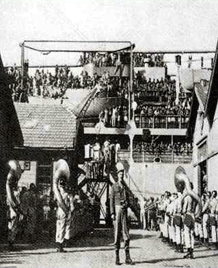 Netherlands
Netherlands
List for UN Allies
Background of Participation
As the UN Security Council passed the resolution calling for military assistance to South Korea, the Netherlands decided on July 16, 1950, to dispatch one destroyer, the Evertsen. When the UN Secretary General had asked for dispatching ground forces, Netherlands refused for domestic reasons. As mass media and public opinion pressed the government for sending ground forces to Korea, however, the Dutch government decided on August 28th to organize one infantry battalion to send to South Korea. The Netherlands created a battalion by selecting 646 volunteers, and appointed Lieut. Colonel Den Ouden as its commander on September 9th. The Dutch Battalion arrived in Pusan on November 23rd, and moved to the UN camp in Daegu.
Activity of the Ground Force
The Dutch Battalion, attached to the US 2nd Division, moved to near Hoengsong on January 2, 1951, when Chinese New Year offensive was launched. The reconnaissance unit of the A Company was isolated by North Korean attack. The company suffered two deaths and seven wounded while rescuing the reconnaissance unit.
On February 4th, the Dutch Battalion was deployed at Huchon, north of Hoengsong to cover ROK forces attacking Hongchon. When the Battalion was covering the retreat of ROK forces and US fire support unit which were being pushed by CCF February offensive, it lost its commander and fell into confusion. In this battle, the Battalion suffered 17 deaths and 37 wounded.
Immediately after arriving at the Wonju base, the Battalion defended Hill 325 in a joint operation with US forces. After 6 weeks of maintenance period, the Battalion advanced to the north of Hongchon on April 30th. It engaged in offensive and defensive battles on May 16th with CCF which had launched the May offensive. But it was too weak to deter the CCF advancement. The Battalion made a dispersed retreat the following day.
As UN forces launched a counterattack, the Battalion repelled North Korean forces through 6 hours of battle on May 27th. The Dutch soldiers engaged in a battle with retreating North Korean forces on Hill 548, east of Inje, which lasted for three days from May 30th. They killed a number of the enemy, but they also suffered 20 deaths and 31 wounded. After this battle, the Battalion moved to Kusongpo-ri for rest and maintenance.
On July 26, 1951, the Dutch Battalion attacked Mt. Daewu, a strong defensive point of North Korean forces. But the offensive did not succeed because of the enemys strong resistance and numerous mines.
After carrying out the operation of reconnaissance in the area of Hill Eunsong and Hill Paggot, the Battalion moved to Cholwon as a reserve unit on February 5th. Nevertheless, in order to capture POWs, it launched a surprise attack on the Hill Byol(star) which was a CCF main outpost. After preparation fire, the B Company initiated an attack and occupied the Hill Byol(star). The company returned to the main resistance line after destroying three bunkers and a large amount of shells and mines. In this battle, 5 Dutch soldiers were killed and 29 wounded.
After this combat, the Battalion withdrew from the front, and performed the mission of protecting the Koje POW Camp from April 17th to July 14th. The Battalion returned to the front on August 20th, and deployed in Shinhyon-ri, west of Cholwon.At the end of September, in order to secure the Yoke, Uncle, Arsenal, and Eerie outposts, the Dutch Battalion struggled with Chinese forces for outposts at T-bone Ridge. The Dutch Battalion was deployed near Kalhyun-ri, east of Samichon, on January 28, 1953. In March, it engaged in four battles with Chinese forces, and repelled them.With the CCF July offensive, the Dutch forces deployed in Mukog-ri on July 18th. The next day, after shelling with mortar and field-artillery, Chinese troops attacked a platoon of A Company deployed on the Hill Mumyong. As the platoon became enveloped, the Commander of the Battalion fired VT bombs, by which the CCF was seriously damaged. The enemy finally retreated, and A Company recaptured the Hill Mumyong. In this combat, the Battalion killed 19 and captured 1, while suffering 9 deaths and 6 wounded. After conclusion of the armistice, the Battalion withdrew to Jikyong-dong.
Activity of the Navy
The Dutch destroyer, the Evertsen, was attached to the Support Squadron on the Yellow Sea, which was attached mainly with the British Navy, on July 19th. The Evertsen intercepted the enemys supply of armed forces and commodities on the Yellow Sea. Also it called for striking the enemys shore targets from the aircraft carrier. When the Inchon landing was initiated, the destroyer covered the amphibious squadron at Inchons outer port. The Van Galen, which had replaced the Evertsen on April 18, 1951, carried out the operation of bombing the mouth of the Han River and Haeju Bay. On November 18, the destroyer, together with the British fleet, advanced to the East sea, and participated in the operation of blockading Heungnam. After this operation, the Van Galen returned to the Yellow Sea. On January 10th, when the ROK submarine chaser, PC 702, was forced to retreat from the sea near Changrin Island, the Dutch vessel sailed to that location and destroyed the enemys shore fire positions.
The third Dutch destroyer, the Piet Hein, was attached to the Support Squadron on the Yellow Sea. She carried out the mission of defending Cho Island, Baeryong Island, and the mouth of the Han River. The Piet Hein was replaced by the frigate, the Johan Maurits van Naasau on January 18, 1953.On June 6th, the Dutch frigate sailed to the sea near Jinampo, and shelled the enemys shore fire position which had hampered mine sweeping operations. After the armistice, the frigate continued the covering operation in the Yellow Sea.
The Netherlands participated in the Korean war with 5,322 soldiers, 120 of them were killed and 645 wounded. After the armistice the ground forces withdrew from Korea in December, and the Navy in January 1955.

